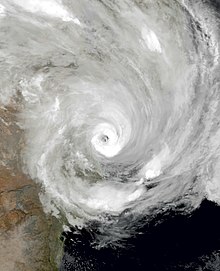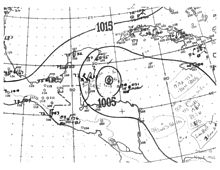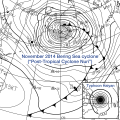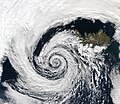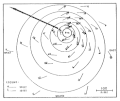The Tropical Cyclones Portal
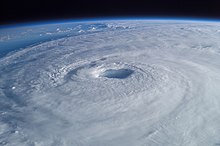
A tropical cyclone is a storm system characterized by a large low-pressure center, a closed low-level circulation and a spiral arrangement of numerous thunderstorms that produce strong winds and heavy rainfall. Tropical cyclones feed on the heat released when moist air rises, resulting in condensation of water vapor contained in the moist air. They are fueled by a different heat mechanism than other cyclonic windstorms such as Nor'easters, European windstorms and polar lows, leading to their classification as "warm core" storm systems. Most tropical cyclones originate in the doldrums, approximately ten degrees from the Equator.
The term "tropical" refers to both the geographic origin of these systems, which form almost exclusively in tropical regions of the globe, as well as to their formation in maritime tropical air masses. The term "cyclone" refers to such storms' cyclonic nature, with anticlockwise rotation in the Northern Hemisphere and clockwise rotation in the Southern Hemisphere. Depending on its location and intensity, a tropical cyclone may be referred to by names such as "hurricane", "typhoon", "tropical storm", "cyclonic storm", "tropical depression" or simply "cyclone".
Types of cyclone: 1. A "Typhoon" is a tropical cyclone located in the North-west Pacific Ocean which has the most cyclonic activity and storms occur year-round. 2. A "Hurricane" is also a tropical cyclone located at the North Atlantic Ocean or North-east Pacific Ocean which have an average storm activity and storms typically form between May 15 and November 30. 3. A "Cyclone" is a tropical cyclone that occurs in the South Pacific and Indian Oceans.
Selected named cyclone -
Tropical Cyclone Eloise was the strongest tropical cyclone to impact the country of Mozambique since Cyclone Kenneth in 2019 and the second of three consecutive tropical cyclones to impact Mozambique in the 2020–21 South-West Indian Ocean cyclone season. The seventh tropical depression, fifth named storm and the second tropical cyclone of the season, Eloise's origins can be traced to a disturbance over the central portion of the South-West Indian Ocean basin which developed into a tropical depression on 16 January, and strengthened into a tropical storm on 17 January, though the storm had limited strength and organization. On the next day, the storm entered a more favorable environment, and it soon intensified to a severe tropical storm on 18 January. Late on 19 January, Eloise made landfall in northern Madagascar as a moderate tropical storm, bringing with it heavy rainfall and flooding. The storm traversed Madagascar and entered the Mozambique Channel in the early hours of 21 January. After moving southwestward across the Mozambique Channel for an additional 2 days, Eloise strengthened into a Category 1-equivalent cyclone, due to low wind shear and high sea surface temperatures. Early on 23 January, Eloise peaked as a Category 2-equivalent tropical cyclone on the Saffir–Simpson scale as the center of the storm began to move ashore in Mozambique. Shortly afterward, Eloise made landfall just north of Beira, Mozambique, before rapidly weakening. Subsequently, Eloise weakened into a remnant low over land on 25 January, dissipating soon afterward.
Preparations for the advancing storm took place in Madagascar before Eloise's landfall and in multiple other African countries. For Madagascar, widespread warnings and alerts were issued as the storm approached northern Madagascar. For Mozambique, high alerts were put in place for central portions of the country. Humanitarian responders prepared for response after the storms passing. Beira's port also closed for about 40 hours, and limited supplies of emergency non-food items were given. Many families were sheltered in tents at accommodation centers, and received kits for food, hygiene, and COVID-19 protection. Officials in Zimbabwe warned of ravine and flash flooding, which may cause infrastructure damage. Several northern provinces of South Africa were expected to experience heavy rains, which prompted severe risk warnings for them. Disaster management teams were placed on high alert ahead of the storm. (Full article...)
Selected article -
The 1942 Belize hurricane was one of only two known hurricanes to strike Belize in the month of November, alongside Hurricane Lisa in 2022. The thirteenth observed tropical cyclone, eleventh tropical storm, and fourth hurricane of the 1942 Atlantic hurricane season, this storm was detected in the vicinity of Turks and Caicos Islands on November 5. Initially a tropical storm, it strengthened slowly while moving westward and then south-southwestward across the Bahamas. On November 6, the storm became a Category 1 hurricane on the modern day Saffir–Simpson hurricane wind scale. Later that day, it made landfall in Cayo Romano, Camagüey Province, Cuba. Impact in Cuba and the Bahamas was limited to lower barometric pressure readings and strong winds. While crossing Cuba, the system weakened to a tropical storm early on November 7, shortly before emerging into the Caribbean Sea. The storm re-strengthened into a hurricane later that day and headed southwestward.
Late on November 8, this system curved westward and intensified into a Category 2 hurricane. Six hours later, it peaked with winds of 110 mph (175 km/h). Early on November 9, the storm struck Caye Caulker and northern Belize District. Rapidly weakening, the system fell to tropical storm status within 12 hours of landfall. By early on November 10, it emerged into the Bay of Campeche. The storm meandered erratically until striking the Yucatán Peninsula on November 11 and dissipating hours later. Strong winds were observed in Belize and Mexico's Yucatan Peninsula. Severe damage was reported in the former. About 90% of structures in San Pedro Town were destroyed, while Newtown was obliterated, causing its residents to relocate and establish the village of Hopkins. Trees and crops such as coconuts also suffered heavy losses. Overall, nine deaths and approximately $4 million (1942 USD) in damage were reported. (Full article...)
Selected image -
Selected season -

The 1995 Pacific hurricane season was the least active Pacific hurricane season since 1979,[1] and marked the beginning of a multi-decade period of low activity in the basin. Of the eleven tropical cyclones that formed during the season, four affected land, with the most notable storm of the season being Hurricane Ismael, which killed at least 116 people in Mexico. The strongest hurricane in the season was Hurricane Juliette, which reached peak winds of 150 mph (240 km/h), but did not significantly affect land. Hurricane Adolph was an early-season Category 4 hurricane. Hurricane Henriette brushed the Baja California Peninsula in early September.
The season officially started on May 15, 1995, in the Eastern Pacific, and on June 1, 1995, in the Central Pacific, and lasted until November 30, 1995. These dates conventionally delimit the period of each year when most tropical cyclones form in the northeastern Pacific Ocean. The season saw eleven tropical cyclones form, of which ten became tropical storms. Seven of these storms attained hurricane status, three of them becoming major hurricanes. There were fewer tropical storms than the average of 16, while the number of hurricanes and major hurricanes were slightly below average. (Full article...)
Related portals
Currently active tropical cyclones

Italicized basins are unofficial.
- North Atlantic (2024)
- No active systems
- East and Central Pacific (2024)
- No active systems
- West Pacific (2024)
- No active systems
- North Indian Ocean (2024)
- No active systems
- Mediterranean (2024–25)
- No active systems
- South-West Indian Ocean (2024–25)
- No active systems
- Australian region (2024–25)
- No active systems
- South Pacific (2024–25)
- No active systems
- South Atlantic (2024–25)
- No active systems
Last updated: 22:43, 22 November 2024 (UTC)
Tropical cyclone anniversaries

November 26
- 1974 - Typhoon Irma reached its peak intensity with 215 km/h (135 mph) winds to the east of the Philippines.
- 1990 - Cyclone Sina maintains strength as it affects Fiji, causing damages of up to $18.7 million.
- 2003 - Typhoon Lupit (pictured) reached its maximum intensity as a Category 5 with 1-minute sustained winds of 270 km/h (165 mph). Lupit only caused minor damages over in the Pacific Islands.

November 27
- 1982 - Typhoon Pamela (pictured) reached its peak intensity as a 185 km/h (115 mph) typhoon as it passed through the Marshall Islands. Pamela caused extensive damage throughout several Pacific Islands.
- 2001 - Hurricane Olga reaches its peak strength as a Category 1 hurricane well to the east of Bermuda.
- 2013 - Cyclone Lehar makes landfall over in the Andhra Pradesh region.

November 28
- 2000 - Cyclone BOB 05 makes landfall near Cuddalore, which resulted in only 12 deaths and damages of up to ₹700 million rupees ($15 million USD).
- 2005 - Tropical Storm Delta became an extratropical cyclone as it passed to the north of the Canary Islands. The cyclone caused more than $350 million of damage.
Did you know…
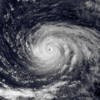



- …that the Joint Typhoon Warning Center considers that Typhoon Vera (pictured) of 1986 is actually two distinct systems, formed from two separated low-level circulations?
- …that Cyclone Freddy (track pictured) in 2023 was the longest-lasting tropical cyclone recorded?
- …that the typhoons of 2024—Yinxing, Toraji, Usagi, and Man-yi (pictured)—made history as the first recorded instance since 1951 of four tropical cyclones coexisting in November?
- …that Hurricane Otis (pictured) in 2023 was the first Pacific hurricane to make landfall at Category 5 intensity and surpassed Hurricane Patricia as the strongest landfalling Pacific hurricane on record?
General images -

The 2013 Atlantic hurricane season was an event in the annual hurricane season in the north Atlantic Ocean. It featured below-average tropical cyclone activity, with the fewest hurricanes since the 1982 season. The season officially began on June 1, 2013 and ended on November 30, 2013. These dates, adopted by convention, historically delimit the period in each year when most tropical systems form. The season's first storm, Tropical Storm Andrea formed on June 5, and its final storm, an unnamed subtropical storm, dissipated on December 7. Altogether, there were 13 named tropical storms during the season. Two of which attained hurricane strength, but neither intensified into a major hurricane, the first such occurrence since the 1994 season.
Despite the season's below-average activity overall, three Atlantic storms made Landfall in Mexico, two as tropical storms and one as a hurricane. Hurricane Ingrid made landfall on September 15, near La Pesca, Tamaulipas, on September 15, killing 23 and causing $1.5 billion (2013 USD) in damage. That same month, on the opposite side of the country, Hurricane Manuel made multiple landfalls along Mexico's Pacific coast, causing catastrophic damage. The only tropical storm to make landfall in the United States was Andrea. After coming ashore in Florida's Big Bend region, it killed at least three and brought tornadoes, heavy rainfall, and flooding to a large section of the U.S. East Coast and Atlantic Canada. (Full article...)
Topics
Subcategories
Related WikiProjects
WikiProject Tropical cyclones is the central point of coordination for Wikipedia's coverage of tropical cyclones. Feel free to help!
WikiProject Weather is the main center point of coordination for Wikipedia's coverage of meteorology in general, and the parent project of WikiProject Tropical cyclones. Three other branches of WikiProject Weather in particular share significant overlaps with WikiProject Tropical cyclones:
- The Non-tropical storms task force coordinates most of Wikipedia's coverage on extratropical cyclones, which tropical cyclones often transition into near the end of their lifespan.
- The Floods task force takes on the scope of flooding events all over the world, with rainfall from tropical cyclones a significant factor in many of them.
- WikiProject Severe weather documents the effects of extreme weather such as tornadoes, which landfalling tropical cyclones can produce.
Things you can do
 |
Here are some tasks awaiting attention:
|
Wikimedia
The following Wikimedia Foundation sister projects provide more on this subject:
-
Commons
Free media repository -
Wikibooks
Free textbooks and manuals -
Wikidata
Free knowledge base -
Wikinews
Free-content news -
Wikiquote
Collection of quotations -
Wikisource
Free-content library -
Wikiversity
Free learning tools -
Wikivoyage
Free travel guide -
Wiktionary
Dictionary and thesaurus
- ^ National Hurricane Center; Hurricane Research Division; Central Pacific Hurricane Center (April 26, 2024). "The Northeast and North Central Pacific hurricane database 1949–2023". United States National Oceanic and Atmospheric Administration's National Weather Service. Archived from the original on May 29, 2024. A guide on how to read the database is available here.
 This article incorporates text from this source, which is in the public domain.
This article incorporates text from this source, which is in the public domain.
